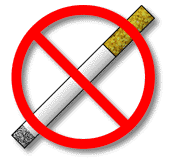
A Puff
full of Poison
Epidemiologists
estimate that 50% of smokers will die of smoking if they do not
give up - and it is not the case that they only lose a few years;
a quarter of a century is more likely for those dying between the
age 35 and 69. World wide smoking is the leading cause of
preventable illness and death. Every year more
Americans die from smoking than from all accidents, infectious
diseases, murders, suicides, diabetes, and cirrhosis combined
together. In fact the annual tally, is more than all of the
Americans killed in World War II. Reason enough to know the Toxins
in the Smoke Bomb.
Of the
many toxic substances in tobacco smoke three are particularly
important for the above mentioned mortality and morbidity.
- Nicotine
is the principal substance that causes addiction to
tobacco. It stimulates the release of
epinephrine--adrenaline--into the smoker's bloodstream,
forcing the heart to work harder (and offering a possible
explanation for why smokers have raised blood pressure). By
constricting blood vessels, including the coronary arteries,
nicotine compromises the heart's own blood supply.
- Carbon
monoxide
the same gas in car exhaust that's lethal in
closed spaces, is a major component of the inhaled smoke and
gets into your blood, reducing the amount of oxygen carrying
capacity of your blood to the heart and the rest of the body.
- The
effects on the circulatory system are both immediate and
dangerous. Nicotine is a stimulant which raises the
heart rate and blood pressure, constricts the arteries,
and, in conjunction with carbon monoxide, causes
atherosclerotic conditions within the artery walls. This
clogging process affects the heart and may lead to
ischemia (a lack of blood flow and oxygen to the heart
muscle) and cause chest pain (angina) or a heart attack as
well as other sites of the body such as the brain or
peripheral circulation in the extremities, sometimes
resulting in gangrene and amputations. Over 200,000
of smoking related deaths are attributed to the combined
effect of nicotine and carbon monoxide on the circulatory
system.
- Even
inhaling second-hand smoke causes an estimated 37,000 to
40,000 deaths from cardiovascular disease each year.
- Tar
in tobacco produces chronic irritation of the respiratory
system and is a major cause of lung cancer.
- One
hundred years ago, lung cancer was so uncommon that if a
doctor ever saw a case of it he would have written it up
in a medical journal. Even as recently as 1930
most doctors never came across a case of primary lung
cancer. This disease, which 50 years ago was
almost unheard of, is now the leading cause of cancer
deaths in men and women. Lung cancer accounts for
one third of all cancer deaths of men. Lung cancer
was once believed to be predominantly a disease of
males. By the mid 1980's, lung cancer overtook
breast cancer to become the number one cause of cancer
deaths in women. Over 85% of the people who die of
lung cancer could avoid the disease completely if they
just didn't smoke.
- Besides
the lungs, other sites where cigarettes exert a
carcinogenic effect include: mouth, lip, tongue, larynx,
pharynx, and esophagus. In addition, cigarettes
contribute to cancers of the kidney, bladder, pancreas
and stomach.
- Besides
these effects, smoking is the main cause of chronic
respiratory lung diseases such as Chronic
obstructive pulmonary diseases (COPD). COPD,
such as emphysema and chronic bronchitis, are major
cripplers caused by cigarette smoking. While
emphysema is not as deadly as lung cancer, patients with
it often envy patients with cancer. People with
lung cancer will usually die within six months of
diagnosis. Patients with advanced stages of
emphysema are permanently crippled, but it may take
years for them to die from it. In its later
stages, emphysema is a living hell.
Some
smokers come into our clinics wondering if they need to quit
smoking. They claim to feel fine. No symptoms of any
diseases are yet obvious. Even their doctors say they
appear normal. Unfortunately, the first sign of some of
the smoking related illnesses is sudden death. This is not
a preferrable time to consider smoking cessation. The best
time to quit to maintain the optimal benefits from not smoking
is when you are alive and relatively healthy. If you are
off cigarettes now, stay off. Your risk of all of the
smoking related illnesses will eventually drop down to that of a
non-smoker. They can still happen, but it is much less
likely. If you currently smoke you will destroy more
tissue and cause more damage and irritation every day you smoke.
We
only have one body and one life. Some people feel they
should have a choice to do the most with the time they have, so
they should eat, drink, smoke and be merry. These people
are partially correct. We should have the choice of what
we can do to obtain the most fun and fulfilling life. But
going through a long crippling period, followed by a long
lingering death is not the best utilization of time. It is
not fun. Consider all of the risks in comparison to the
momentary pleasures the minority of your cigarettes brought you.
Give yourself a chance for a long, productive and happy
life.
When
things get rough and you feel like you want a cigarette, just
take it one day at a time. You can always go out and buy
cigarettes tomorrow. You cannot go out and buy health.
I guess that is why it is said that "The best things
in life are free." Stay free and if enslaved time to
break free.
________________
 Classifying
the dead end
| Classifying
the dead end
|  A
friend in need is a friend indeed A
friend in need is a friend indeed
Quit
smoking index page
|
